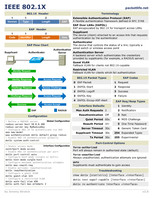IEEE 802.1X is an IEEE Standard for port-based Network Access Control (PNAC). It is part of the IEEE 802.1 group of networking protocols. It provides an authentication mechanism to devices wishing to attach to a LAN or WLAN.
IEEE 802.1X defines the encapsulation of the Extensible Authentication Protocol (EAP) over IEEE 802, which is known as "EAP over LAN" or EAPOL. EAPOL was originally designed for IEEE 802.3 Ethernet in 802.1X-2001, but was clarified to suit other IEEE 802 LAN technologies such as IEEE 802.11 wireless and Fiber Distributed Data Interface (ISO 9314-2) in 802.1X-2004. The EAPOL protocol was also modified for use with IEEE 802.1AE (“MACsec”) and IEEE 802.1AR (Secure Device Identity, DevID) in 802.1X-2010 to support service identification and optional point to point encryption over the local LAN segment.
Overview
EAP data is first encapsulated in EAPOL frames between the Supplicant and Authenticator, then re-encapsulated between the Authenticator and the Authentication server using RADIUS or Diameter.
802.1X authentication involves three parties: a supplicant, an authenticator, and an authentication server. The supplicant is a client device (such as a laptop) that wishes to attach to the LAN/WLAN - though the term 'supplicant' is also used interchangeably to refer to the software running on the client that provides credentials to the authenticator. The authenticator is a network device, such as an Ethernet switch or wireless access point; and the authentication server is typically a host running software supporting the RADIUS and EAP protocols.
The authenticator acts like a security guard to a protected network. The supplicant (i.e., client device) is not allowed access through the authenticator to the protected side of the network until the supplicant’s identity has been validated and authorized. An analogy to this is providing a valid visa at the airport's arrival immigration before being allowed to enter the country. With 802.1X port-based authentication, the supplicant provides credentials, such as user name/password or digital certificate, to the authenticator, and the authenticator forwards the credentials to the authentication server for verification. If the authentication server determines the credentials are valid, the supplicant (client device) is allowed to access resources located on the protected side of the network.
Protocol operation
EAPOL operates at the network layer on top of the data link layer, and in Ethernet II framing protocol has an EtherType value of 0x888E.
Port entities
802.1X-2001 defines two logical port entities for an authenticated port—the "controlled port" and the "uncontrolled port". The controlled port is manipulated by the 802.1X PAE (Port Access Entity) to allow (in the authorized state) or prevent (in the unauthorized state) network traffic ingressing and egressing to/from the controlled port. The uncontrolled port is used by the 802.1X PAE to transmit and receive EAPOL frames.
802.1X-2004 defines the equivalent port entities for the supplicant; so a supplicant implementing 802.1X-2004 may prevent higher level protocols being used if it is not content that authentication has successfully completed. This is particularly useful when an EAP method providing Mutual Authentication is used, as the supplicant can prevent data leakage when connected to an unauthorized network.
Typical authentication progression
The typical authentication procedure consists of:
Sequence diagram of the 802.1X progression
- Initialization On detection of a new supplicant, the port on the switch (authenticator) is enabled and set to the "unauthorized" state. In this state, only 802.1X traffic is allowed; other traffic, such as the Internet Protocol (and with that TCP and UDP), is dropped.
- Initiation To initiate authentication the authenticator will periodically transmit EAP-Request Identity frames to a special Layer 2 address on the local network segment. The supplicant listens on this address, and on receipt of the EAP-Request Identity frame it responds with an EAP-Response Identity frame containing an identifier for the supplicant such as a User ID. The authenticator then encapsulates this Identity response in a RADIUS Access-Request packet and forwards it on to the authentication server. The supplicant may also initiate or restart authentication by sending an EAPOL-Start frame to the authenticator, which will then reply with an EAP-Request Identity frame.
- Negotiation (Technically EAP negotiation) The authentication server sends a reply (encapsulated in a RADIUS Access-Challenge packet) to the authenticator, containing an EAP Request specifying the EAP Method (The type of EAP based authentication it wishes the supplicant to perform). The authenticator encapsulates the EAP Request in an EAPOL frame and transmits it to the supplicant. At this point the supplicant can start using the requested EAP Method, or do an NAK ("Negative Acknowledgement") and respond with the EAP Methods it is willing to perform.
- Authentication If the authentication server and supplicant agree on an EAP Method, EAP Requests and Responses are sent between the supplicant and the authentication server (translated by the authenticator) until the authentication server responds with either an EAP-Success message (encapsulated in a RADIUS Access-Accept packet), or an EAP-Failure message (encapsulated in a RADIUS Access-Reject packet). If authentication is successful, the authenticator sets the port to the "authorized" state and normal traffic is allowed, if it is unsuccessful the port remains in the "unauthorized" state. When the supplicant logs off, it sends an EAPOL-logoff message to the authenticator, the authenticator then sets the port to the "unauthorized" state, once again blocking all non-EAP traffic.

